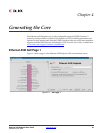
Ethernet AVB Endpoint User Guide www.xilinx.com 43
UG492 July 23, 2010
Functional Block Description
Tx Arbiter
Data for transmission over an AVB network can be obtained from three types of sources:
1. AV Tr affic . For transmission from the AV Traffic I/F of the core.
2. Precise Timing Protocol (PTP) Packets. Initiated by the software drivers using the
dedicated hardware “Tx PTP Packet Buffers.”
3. Legacy Traffic. For transmission from the Legacy Traffic I/F of the core.
The transmitter (Tx) arbiter must prioritize these packets. To aid with this, the arbiter
contains configuration registers that can be used to set the percentage of available Ethernet
bandwidth reserved for AV traffic. To comply with the specifications, this should not be
configured to exceed 75%. The arbiter then polices this bandwidth restriction for the AV
traffic and ensures that on average, it is never exceeded. Consequently, despite the AV
traffic having a higher priority than the legacy traffic, there is always remaining bandwidth
available to schedule legacy traffic. The output of the arbiter should be connected directly
to the client Tx interface of the connected Ethernet MAC, as illustrated. See Chapter 6,
“Ethernet AVB Endpoint Transmission,” for further information.
Rx Splitter
The input to the splitter is connected directly to the client Receive (Rx) interface of the
connected Ethernet MAC. Received data from an AVB network can be of three types:
• Precise Timing Protocol (PTP) Packets. Routed to the dedicated hardware “Rx PTP
Packet Buffers” which can be accessed by the “Software Drivers.” PTP packets are
identified by searching for a specific value in the MAC Length/Type field.
• AV Traffic. Routed to the AV Traffic I/F of the core. These packets are identified by
searching for MAC packets containing a MAC VLAN field with one of two possible
configurable VLAN priority values; the VLAN priorities are defaulted to values of 3
and 2.
• Legacy Traffic:. Routed to the Legacy Traffic I/F of the core. All packet types which
are not identified as PTP or AV Traffic will be considered legacy traffic.
See Chapter 7 for further information.
MAC Header Filters
The MAC Header Filters provided on the receiver legacy traffic path when the core is
generated in “Standard CORE Generator Format”. These filters provide a greater flexibility
than the standard address filter provided in the LogiCORE IP Tri-Mode Ethernet MACs
(which must be disabled). The MAC Header Filters include the ability to filter across any of
the initial 16-bytes of an Ethernet frame, including the ability to filter only on the
Destination Address, Length/Type Field, VLAN tag (if present), or any bit-wise match
combination of the preceding. Eight individual MAC Header Filters are provided, each of
which is separately configured. See Chapter 7, “Ethernet AVB Endpoint Reception” for
further information.
When the core is generated in “EDK pcore Format”, the “Legacy MAC Header Filters” are
not included since the xps_ll_temac can optionally contain its own Address Filter logic.


















